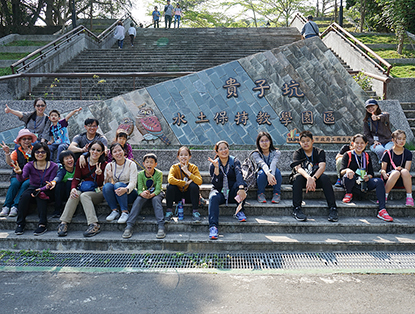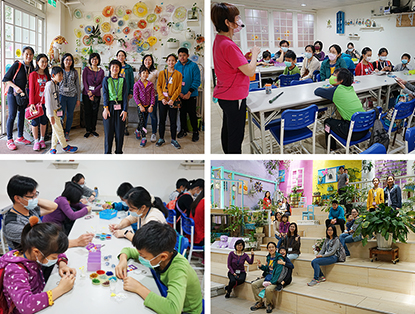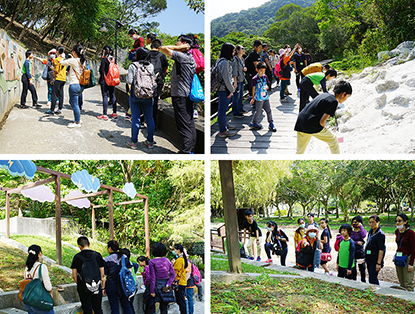Sketch of Archilife Study Tour, April 2021
|
2021年4月份見識之旅縮影  4月份見識之旅活動,於2021年4月11日由呂明澐小姐帶領13位祐生見習生及家長們,進行貴子坑水土保持暨琉璃藝術美學之旅。出發當日天氣晴朗,見習生們及其家長準時集合並出發。活動開始之初,領隊呂明澐小姐提醒本次活動注意事項及觀察重點,先行建立見習生的背景知識。 4月份見識之旅活動,於2021年4月11日由呂明澐小姐帶領13位祐生見習生及家長們,進行貴子坑水土保持暨琉璃藝術美學之旅。出發當日天氣晴朗,見習生們及其家長準時集合並出發。活動開始之初,領隊呂明澐小姐提醒本次活動注意事項及觀察重點,先行建立見習生的背景知識。For the study tour of April 11, 2021, Ms. Lu Ming-yun led 13 ARF interns and their parents on a tour to learn about water and soil conservation in Guizikeng and the aesthetics of glass art. It was clear and sunny on the day of the tour, and the interns and their parents were on time for the departure. At the start of the day's activities, team leader Ms. Lu Ming-yun reminded everyone about things to note and what to observe, and gave the interns some background knowledge.  本次上午行程前往琉傳天下藝術館,該館理念旨在結合藝術與自然人文,落實藝術生活化,讓琉璃不再只是遙不可及的精品工藝。行程之初,導覽人員說明琉璃是玻璃的一種,它們之間的關係如同訂製禮服與批量化成衣一般,琉璃藝術品除了使用的材料成本高之外,亦匯集設計者的創作理念及巧思才能製作出一件成品,相較於能大批量產出的玻璃,反而昂貴許多。琉璃創作有許多技法,基本上以拉絲熱塑、脫蠟鑄造、融合及吹製等四種技法為主,其中特別透過影片解說吹製技法,以花瓶為例,吹製過程中,作品須不斷重複進入爐中加熱,避免瓶身裡外冷熱不均而裂開,同理,完成後須於徐冷爐中慢慢放涼,琉璃花瓶、盤子、燈罩等多是以此技法製作。觀看完畢後,即進行有獎徵答,複習影片內容、加深觀看印象,氣氛十分熱絡。 本次上午行程前往琉傳天下藝術館,該館理念旨在結合藝術與自然人文,落實藝術生活化,讓琉璃不再只是遙不可及的精品工藝。行程之初,導覽人員說明琉璃是玻璃的一種,它們之間的關係如同訂製禮服與批量化成衣一般,琉璃藝術品除了使用的材料成本高之外,亦匯集設計者的創作理念及巧思才能製作出一件成品,相較於能大批量產出的玻璃,反而昂貴許多。琉璃創作有許多技法,基本上以拉絲熱塑、脫蠟鑄造、融合及吹製等四種技法為主,其中特別透過影片解說吹製技法,以花瓶為例,吹製過程中,作品須不斷重複進入爐中加熱,避免瓶身裡外冷熱不均而裂開,同理,完成後須於徐冷爐中慢慢放涼,琉璃花瓶、盤子、燈罩等多是以此技法製作。觀看完畢後,即進行有獎徵答,複習影片內容、加深觀看印象,氣氛十分熱絡。The morning's itinerary took everyone to Glastory Arts Center. It is the mission of the center to combine arts with nature and culture, and integrate arts into everyday life, bringing designer art glass closer to the masses. The tour guide began by explaining that art glass is a type of glass; the difference between them is like the difference between haute couture and mass-market apparel. Besides the use of costly materials, each piece of art glass is also the result of the designer's creative concept and idea, making it significantly more expensive than mass produced glass. There are basically four skills of shaping glass, including hot sculpting, lost-wax casting, fusing and blowing. The tour guide showed a video of how the blowing technique is applied. When making a vase, the glass has to be repeatedly heated in the furnace during the blowing process to prevent the vase from cracking due to the difference in temperature outside and inside the vase. When completed, it has to be cooled slowly as well to prevent cracking. Glass vase, plates and lamp shades are mostly made using this technique. To review the content of the video and deepen everyone's impression, there was a quiz with prizes to be won at the end of the video which got everyone excited and involved.  下午前往貴子坑水土保持園區參訪。貴子坑屬台北最古老地層「五指山層」,富含高嶺土及石英砂等瓷器產業原料,日治時期被發現後大量開採,彼時尚無水土保持觀念,導致多年後下游受到土石流嚴重侵害,近年來在政府規劃下開始進行水土保持相關整治作業,並成立教育園區。園區志工老師帶領眾人認識山坡土石流防治與河川整治常用的工程方法,藉由展示邊坡穩定、排水設施及互動裝置,讓見習生易於了解設計原理。此外,園區保留地層裸露的部分,岩層因含有高嶺土而呈現白色,其砂粉觸摸起來十分細緻,細緻而且高黏著度的特性,是瓷器的重要原料。抬頭望向岩層裸露處上方,能近距離看到褶曲地形的樣貌,令人驚嘆大自然之力。隨後眾人觀察人工降雨沖蝕槽,雨水沖刷灌木植栽區、草地植栽區及地表裸露區三個區域的地表,比較其中水土保持成效的差異,雨水流經灌木叢逐漸被削減沖刷力道,使土壤不受雨水沖蝕,因此效益最佳。至此,本日活動已近尾聲,大家一起合照留念後搭車返程,並期待於下次見識之旅再相見。 下午前往貴子坑水土保持園區參訪。貴子坑屬台北最古老地層「五指山層」,富含高嶺土及石英砂等瓷器產業原料,日治時期被發現後大量開採,彼時尚無水土保持觀念,導致多年後下游受到土石流嚴重侵害,近年來在政府規劃下開始進行水土保持相關整治作業,並成立教育園區。園區志工老師帶領眾人認識山坡土石流防治與河川整治常用的工程方法,藉由展示邊坡穩定、排水設施及互動裝置,讓見習生易於了解設計原理。此外,園區保留地層裸露的部分,岩層因含有高嶺土而呈現白色,其砂粉觸摸起來十分細緻,細緻而且高黏著度的特性,是瓷器的重要原料。抬頭望向岩層裸露處上方,能近距離看到褶曲地形的樣貌,令人驚嘆大自然之力。隨後眾人觀察人工降雨沖蝕槽,雨水沖刷灌木植栽區、草地植栽區及地表裸露區三個區域的地表,比較其中水土保持成效的差異,雨水流經灌木叢逐漸被削減沖刷力道,使土壤不受雨水沖蝕,因此效益最佳。至此,本日活動已近尾聲,大家一起合照留念後搭車返程,並期待於下次見識之旅再相見。The afternoon's itinerary was a visit to Guizikeng Water and Soil Conservation Education Park. Guizikeng is part of Taipei's oldest stratum "Wuchishan Formation", which is rich in raw materials used in the ceramics industry, including kaolin and quartz sand. Its discovery during the Japanese Occupation led to intensive excavation, resulting in severe landslide in the downstream area years after as environmental conservation was not a known concept at the time. In recent years, efforts have been made by the government to improve water and soil conservation, and the education park has been established. Led by the park's volunteer tour guide, everyone learned the common techniques used to prevent landslide and improve rivers. Through the display of slope stabilizing and drainage facilities, and interactive devices, interns were able to understand the principles behind these designs easily. The park also displays exposed areas of the stratum, which has a whitish appearance because of its kaolin content. Due to its smooth texture, and high adhesive strength, it is an important raw material used to make ceramics. Folded strata can also be seen on top of the exposed area, leaving everyone awestruck by the power of nature. Next, everyone proceeded to observe an artificial rainfall simulator, which shows rainfall over shrubs, a lawn and an exposed soil surface. The simulator shows that the shrubs can gradually diminish the force of rainfall, protecting the soil from erosion and is best of the three in soil conservation. At this point, the day's itinerary came to an end. Everyone took a group photo before heading back and looked forward to the next study tour. |

